



As a brief introduction to ASTR 350, to supplement the Course Description, here we survey the course, which provides a glimpse of our local cosmos, and highlights some of the exotic and fascinating objects and phenomena that are found in the Milky Way. This gallery is a representative (but of course incomplete) sampling of the material covered in the course.
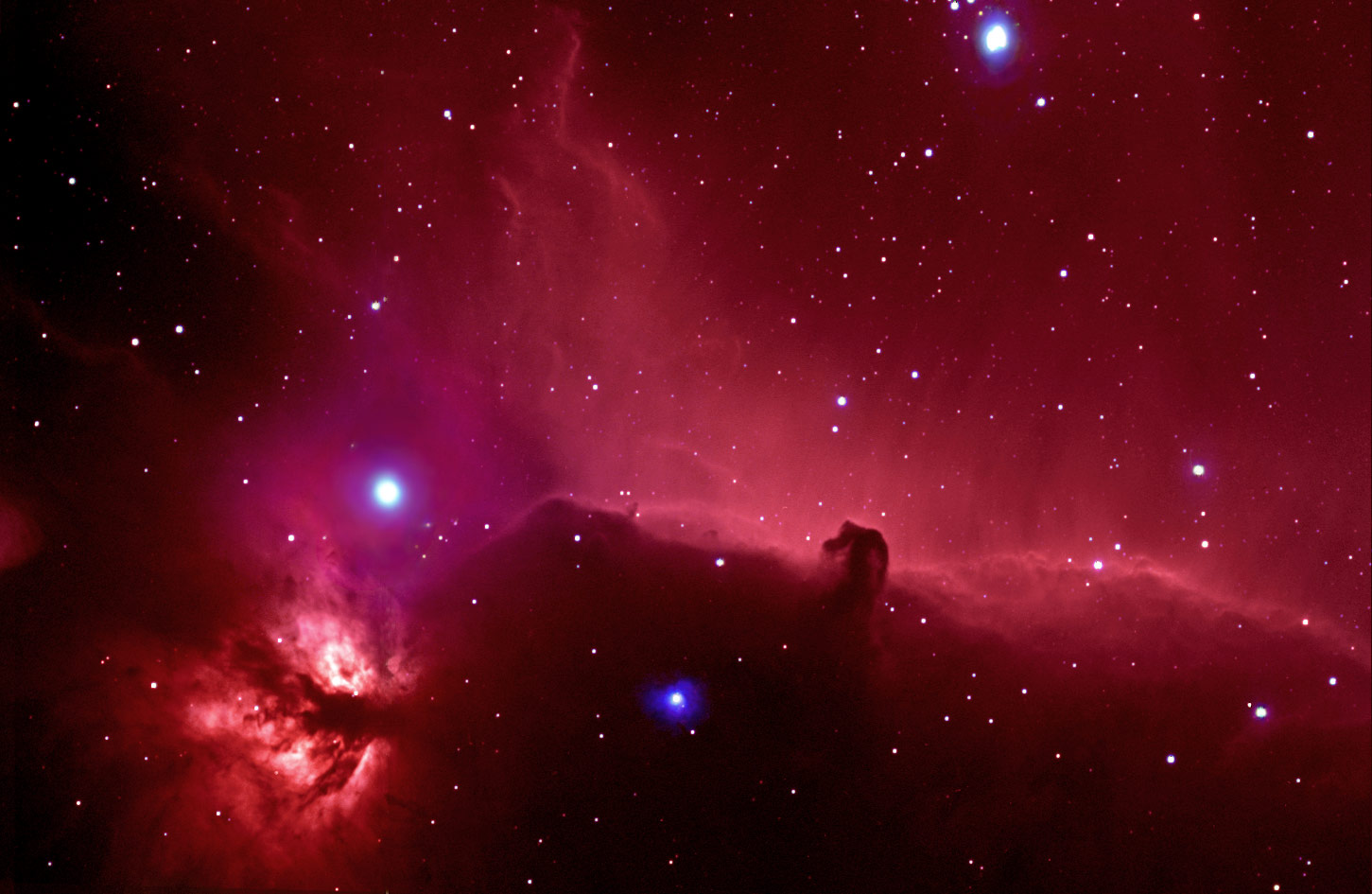 The cosmos possesses a wealth of different systems, ranging from the
more obvious local objects such as the sun, planets and asteroids, and
then the more distant stars and nebulae, to more subtle manifestations
such as stellar winds, various ionized or neutral gas clouds, and
exotic, compact stars. Many are present in the Milky Way, which forms
the lens for our brief foray into the astrophysics of the cosmos. At
left is an optical image of the Horsehead nebula and its environs.
The cosmos possesses a wealth of different systems, ranging from the
more obvious local objects such as the sun, planets and asteroids, and
then the more distant stars and nebulae, to more subtle manifestations
such as stellar winds, various ionized or neutral gas clouds, and
exotic, compact stars. Many are present in the Milky Way, which forms
the lens for our brief foray into the astrophysics of the cosmos. At
left is an optical image of the Horsehead nebula and its environs.
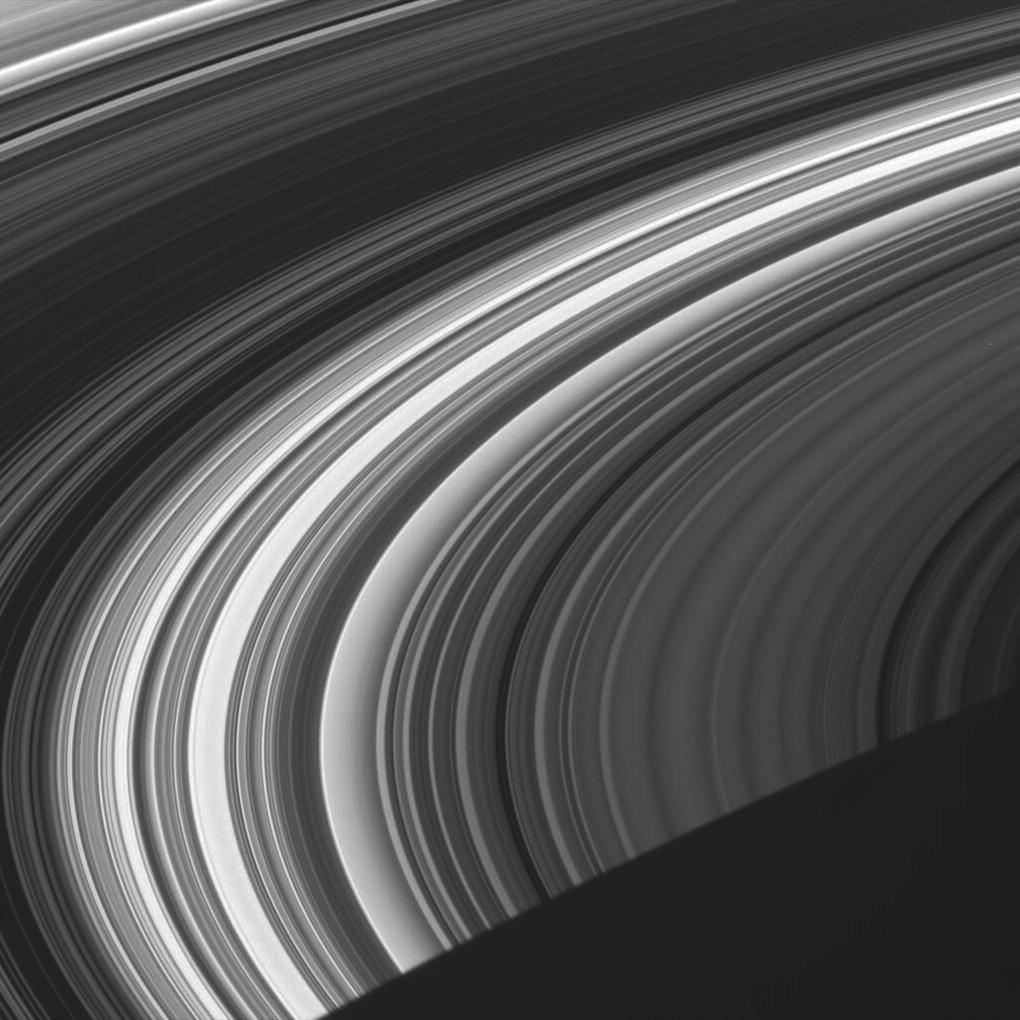 The course begins with an exploration of the objects in the solar
system. The focal point here is the ancient astronomical science of
celestial mechanics, which was how astronomers first discovered the rich
diversity of cosmic neighbors. Planetary motions will be explored, as
will tidal forces, and properties of comets and asteroids, and the rings
of Saturn will be touched upon. Extrasolar planet searches will be
discussed. On the right is one of Cassini's
stunning images of Saturn's rings during its recent rendezvous.
The course begins with an exploration of the objects in the solar
system. The focal point here is the ancient astronomical science of
celestial mechanics, which was how astronomers first discovered the rich
diversity of cosmic neighbors. Planetary motions will be explored, as
will tidal forces, and properties of comets and asteroids, and the rings
of Saturn will be touched upon. Extrasolar planet searches will be
discussed. On the right is one of Cassini's
stunning images of Saturn's rings during its recent rendezvous.
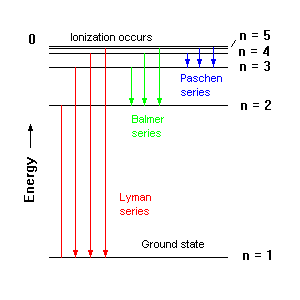 In order to study cosmic systems in some depth, we must apply various
concepts from physics. While celestial mechanics was grounded in
classical mechanics and Newton's theory of gravitation, 20th Century
physics ushered in quantum mechanics, relativity and powerful new tools
for astronomical exploration. Much of modern astronomical research,
whether it focuses on the radio, optical, X-ray or gamma-ray wavebands,
is built upon spectroscopic analysis. ASTR 350 devotes considerable
time to elements of photometry, thermal physics, atomic spectroscopy and
ionization balance to elucidate principal techniques for probing the
physics of cosmic systems. Here the sequence of atomic transitions
for hydrogen is depicted.
In order to study cosmic systems in some depth, we must apply various
concepts from physics. While celestial mechanics was grounded in
classical mechanics and Newton's theory of gravitation, 20th Century
physics ushered in quantum mechanics, relativity and powerful new tools
for astronomical exploration. Much of modern astronomical research,
whether it focuses on the radio, optical, X-ray or gamma-ray wavebands,
is built upon spectroscopic analysis. ASTR 350 devotes considerable
time to elements of photometry, thermal physics, atomic spectroscopy and
ionization balance to elucidate principal techniques for probing the
physics of cosmic systems. Here the sequence of atomic transitions
for hydrogen is depicted.
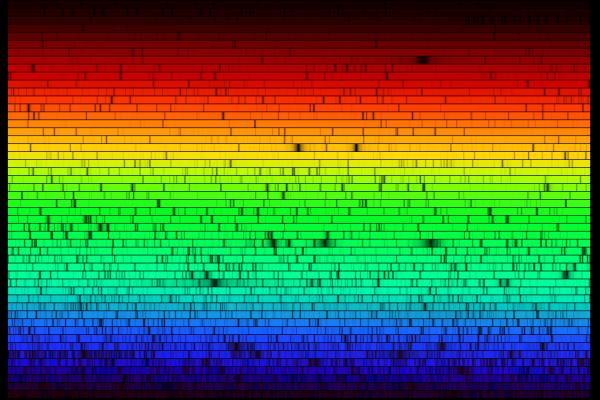 Having assembled a requisite body of physics, the course now studies
solar and stellar spectra and inferences concerning the nature of their
atmospheric layers. Both continuum and line features provide insight on
various properties, including the fundamental characteristic that
stellar interiors are much hotter than their atmospheres. Astronomical
tools such as spectral classification and the Hertzsprung-Russell
diagram will be addressed. To the right is displayed the solar spectrum
in different optical wavebands, highlighting the prominence of
absorption lines.
Having assembled a requisite body of physics, the course now studies
solar and stellar spectra and inferences concerning the nature of their
atmospheric layers. Both continuum and line features provide insight on
various properties, including the fundamental characteristic that
stellar interiors are much hotter than their atmospheres. Astronomical
tools such as spectral classification and the Hertzsprung-Russell
diagram will be addressed. To the right is displayed the solar spectrum
in different optical wavebands, highlighting the prominence of
absorption lines.
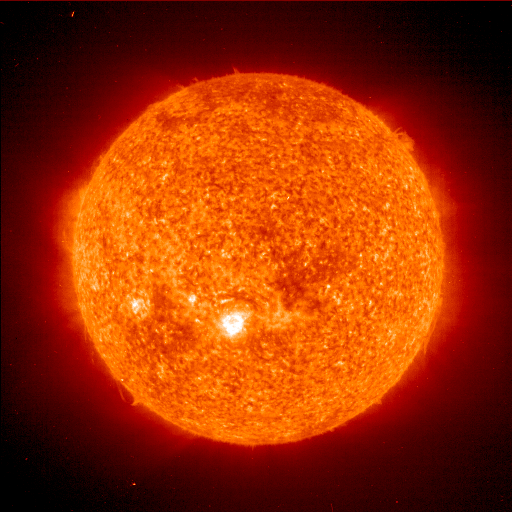 The focus is next on the larger structure of the sun and stars,
exploring their hydrostatic equilibrium, phenomena such as convection,
and the physics of their deep interiors via consideration of the
elements of nucleosynthesis. This portion of the course exhibits why and
for how long stars shine, thereby providing the most essential energy
resource for life on Earth. Concepts from solar physics such as the
solar cycle, solar neutrinos, the coronal regions and the solar wind are
briefly explored. The image to the left is a
SOHO UV picture of the sun
that traces He emission at and above its surface.
The focus is next on the larger structure of the sun and stars,
exploring their hydrostatic equilibrium, phenomena such as convection,
and the physics of their deep interiors via consideration of the
elements of nucleosynthesis. This portion of the course exhibits why and
for how long stars shine, thereby providing the most essential energy
resource for life on Earth. Concepts from solar physics such as the
solar cycle, solar neutrinos, the coronal regions and the solar wind are
briefly explored. The image to the left is a
SOHO UV picture of the sun
that traces He emission at and above its surface.
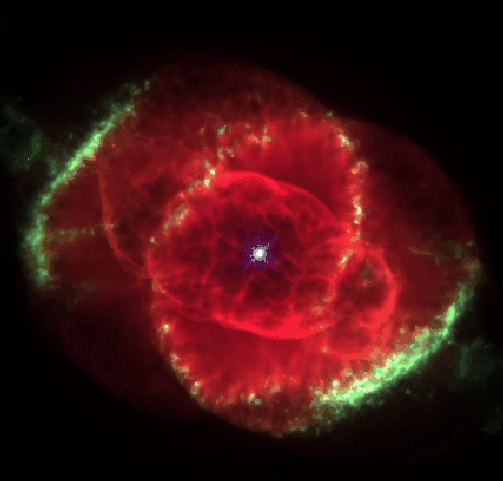 While all stars are born young, like humans, they age and eventually
die. Our serendipitous view of the cosmos now provides a snapshot survey
of a host of different stellar epochs. The course now turns its
attention to the study of stellar evolution, encompassing star formation
via gravitational collapse of gas clouds, through evolution on the main
sequence to giant and supergiant phases. The material differentiates
between the life paths of low mass main sequence stars like the sun and
much more massive stars that evolve rapidly. An image of the planetary
nebula NGC6543 is depicted at right.
While all stars are born young, like humans, they age and eventually
die. Our serendipitous view of the cosmos now provides a snapshot survey
of a host of different stellar epochs. The course now turns its
attention to the study of stellar evolution, encompassing star formation
via gravitational collapse of gas clouds, through evolution on the main
sequence to giant and supergiant phases. The material differentiates
between the life paths of low mass main sequence stars like the sun and
much more massive stars that evolve rapidly. An image of the planetary
nebula NGC6543 is depicted at right.
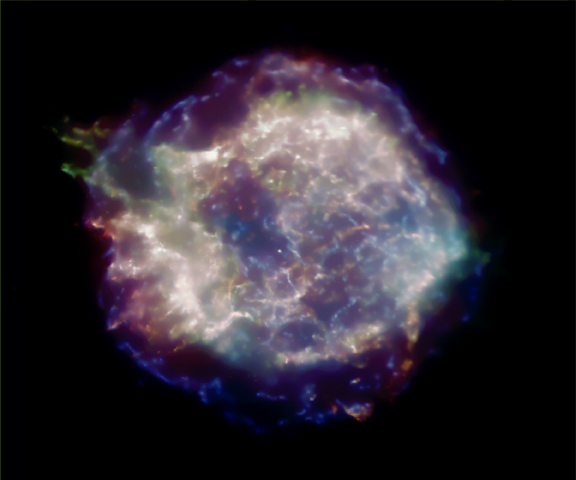 The course naturally progress to the late stages of stellar evolution
and the death of stars. This focus explores phenomena such as stellar
pulsation, eruptions and associated mass loss, planetary nebulae, and
the final catastrophic destruction of a star as a supernova. These
phases are an important component of the matter redistribution in, and
life-cycle of, the Universe. The remnants of supernovae are briefly
discussed. At left is the fascinating X-ray view of the Cassiopeia A
supernova remnant provided by the Chandra X-ray Observatory.
The course naturally progress to the late stages of stellar evolution
and the death of stars. This focus explores phenomena such as stellar
pulsation, eruptions and associated mass loss, planetary nebulae, and
the final catastrophic destruction of a star as a supernova. These
phases are an important component of the matter redistribution in, and
life-cycle of, the Universe. The remnants of supernovae are briefly
discussed. At left is the fascinating X-ray view of the Cassiopeia A
supernova remnant provided by the Chandra X-ray Observatory.
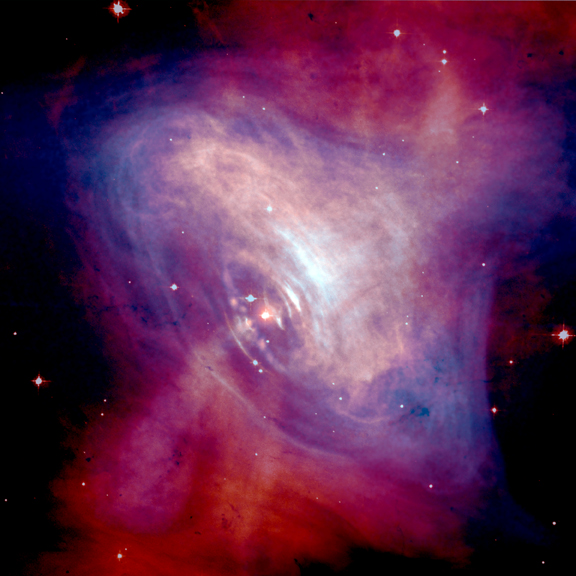 The course wraps up with an "inescapable" foray into the exotic world of
post-main-sequence stars. The study of compact objects, namely white
dwarfs, neutron stars and black holes boggles the mind, providing a
showcase for early 20th Century physics. The lectures outline the role
of quantum degeneracy pressure in stabilizing white dwarfs and neutron
stars against gravitational collapse, identifying the fundamental
Chandrasekhar mass limit for each. Manifestations of neutron stars such
as the pulsar phenomenon are explored, before the course progresses to
the ultimate end state of matter, black holes, and Einstein's theory of
General Relativity. To the
right is a melange of the optical (Hubble Space Telescope)
and X-ray (Chandra X-ray Observatory)
images of the Crab pulsar wind nebula.
The course wraps up with an "inescapable" foray into the exotic world of
post-main-sequence stars. The study of compact objects, namely white
dwarfs, neutron stars and black holes boggles the mind, providing a
showcase for early 20th Century physics. The lectures outline the role
of quantum degeneracy pressure in stabilizing white dwarfs and neutron
stars against gravitational collapse, identifying the fundamental
Chandrasekhar mass limit for each. Manifestations of neutron stars such
as the pulsar phenomenon are explored, before the course progresses to
the ultimate end state of matter, black holes, and Einstein's theory of
General Relativity. To the
right is a melange of the optical (Hubble Space Telescope)
and X-ray (Chandra X-ray Observatory)
images of the Crab pulsar wind nebula.

